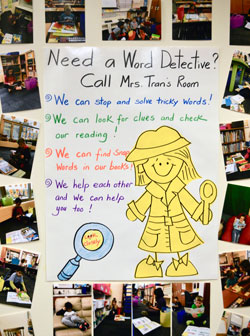Having trouble sounding out tricky words, identifying consonant cousins or picking out vowel teams?
You would be in good hands to ask for help from the 20 or so badge-carrying word detectives in Lana Tran’s first-grade classroom at Knapp Forest Elementary.

For the first full school year, students across the district are using the Units of Study for Teaching Reading, a curriculum developed by author and educator Lucy Calkins.
The four first-grade teachers at Knapp Forest just wrapped up the “Building Good Reading Habits” unit — reading long and strong, solving hard words, and working with a partner — that will help build skills for the rest of the year.
The badges they earned signified that they solved daily missions as detectives-in-training since the start of the school year. They also were given finger flashlights and magnifying glasses to be able to look closely at words while reading.
For example, one lesson, called “Word Detectives don’t let vowels trip them up,” required students to look closely at the vowels inside words, noticing when two vowels are side by side, then try the word one way and then another until it makes sense and sounds right.

Parker Massie used his gumshoe smarts to isolate the vowel team “ou” in “proud,” then the consonant chunk “pr” before putting it together and trying to sound it out until it made sense.
Annabelle Aldridge knows what makes a good reader. The 6-year-old said she has been reading for 20 years.
“We look closely and do everything the teacher says, and we learn,” said the first-grader. “The best part of being a reader is getting badges, getting tools, even reading.”
Already Seeing Gains
Tran, who has been teaching more than 20 years, said she likes Units of Study because it benefits all levels: from non-readers to English language learners to high achievers.

“The teaching points are rigorous and really push kids to think deeply about their books,” she said. “I love that the skills are also extended beyond a single day, which is what first-graders need. I find that I need to do certain lessons two days to give my kids more practice. It feels like there’s an emphasis on mastery rather than simple exposure. It is encouraging for me to see that we continue to revisit the strategies over the course of units.”
Another first-grade teacher, Thresa Clark, said she likes that students are invited to immediately practice what they’ve learned in the mini lesson.
“What is impressive is that when I conference with them, they are able to tell me what they are working on that day,” Clark said. “They love the teaching point sticky note I leave them with after their conference. They are so proud of these that they often have these visible during workshop time. I’m proud of how they set daily goals for how many books they read and do a fantastic job keeping track.”

Added Colleen Buddy, another Knapp Forest first-grade teacher, “I love that students see themselves as readers within a community of readers, and independently plan their daily reading with their goals in mind. Students have clear preferences and intentions and happily recommend books to each other.”
Knapp Forest Principal Scott Haid said it’s too soon to know quantitatively if using Units of Study is impacting standardized test scores, “one thing that we do know for sure is that our students’ reading stamina is way up. We are reading more today — as a building and as a district — than we ever have in the past. We have also increased the amount of non-fiction text that our students read.
“I am very confident that as we continue, we will develop children that love to read and as a by-product, we should see increased test scores.”
More SNN articles about Units of Study:













